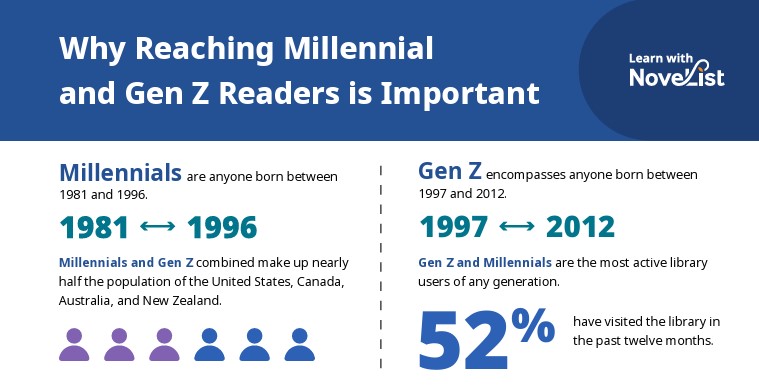Last fall, my 24-year-old daughter checked out a book from our library, “Invisible Women: Data Bias in a World Designed for Men.” By diving into women’s lives at home, workplaces, public spaces, the doctor’s office, and more, the author, Caroline Criado Perez, examines how a gender gap in data perpetuates bias and disadvantages women.
My daughter, who works in a genetic counseling clinic, was one of thousands of Gen Z readers persuaded to read the book by other readers her age on TikTok. She took home the print version, because, in her words, she loves the “feel” of print books. Her millennial counterparts were persuaded by my daughter to read the book because they value recommendations from friends and family. However, they chose to read the eBook format.
We sometimes lump these two generations, Gen Z and millennials, together, assuming they don’t read, or if they do, they only consume digital content. We may also assume that Gen Z and millennials don’t go to the library. We couldn’t be more wrong. In fact, Gen Z and millennial readers are different from one another except for one big fact: They are the most active library users of any generation.
That fact may make you think that you don’t need to focus your outreach and promotional efforts on Gen Z and millennials. But that couldn’t be further from the truth. Nearly half of these two generations still don’t use the library. We know they value recommendations from influencers, friends, and family. That means these two generations are among the easiest to get totally on board with the library. We need to get the current Gen Z and millennial library users to talk to their contemporaries, either on social media or in person.
Now imagine this: If libraries successfully engaged just 25 percent more Gen Z and millennial users, it could increase U.S. public library circulation by more than 300 million items, based on the most current circulation statistics from the 2022 Institute of Museum and Library Services Public Library Report. That’s enough books to cover a thousand football fields! Plus, we could look forward to a larger, more engaged user base that can help advocate for libraries, raising awareness about their importance and ensuring they remain a priority in community planning and development.

So, how do we get to reach and excite more of these young, vibrant potential library users? I put together two new professional development courses to help! How to Reach Gen Z Members of Your Library Community and How to Reach Millennial Members of Your Library Community will teach you effective strategies for engaging these readers through various channels, including social media, email, and in-person interactions. You’ll gain insights into their reading habits, preferred communication methods, and the types of library programs and services that resonate most with them.
In a few months, my coworker Yaika Sabat will release two courses on how to work specifically with Gen Z and millennial readers. Once you get them to engage with the library, you’ll want to make sure they continue to come to your library staff for all their reading needs. All four courses are available exclusively to Learn with NoveList Plus subscribers. Ask for a free demo and trial and start building your library’s relationship with these two important reading generations!
Angela Hursh is Manager of Engagement, Marketing, and Professional Development for NoveList. She is reading Obitchuary: The Big Hot Book of Death by Spencer Henry and Madison Reyes.



